FIAT LINEA 2007 1.G Owners Manual
Manufacturer: FIAT, Model Year: 2007, Model line: LINEA, Model: FIAT LINEA 2007 1.GPages: 230, PDF Size: 3.31 MB
Page 111 of 230
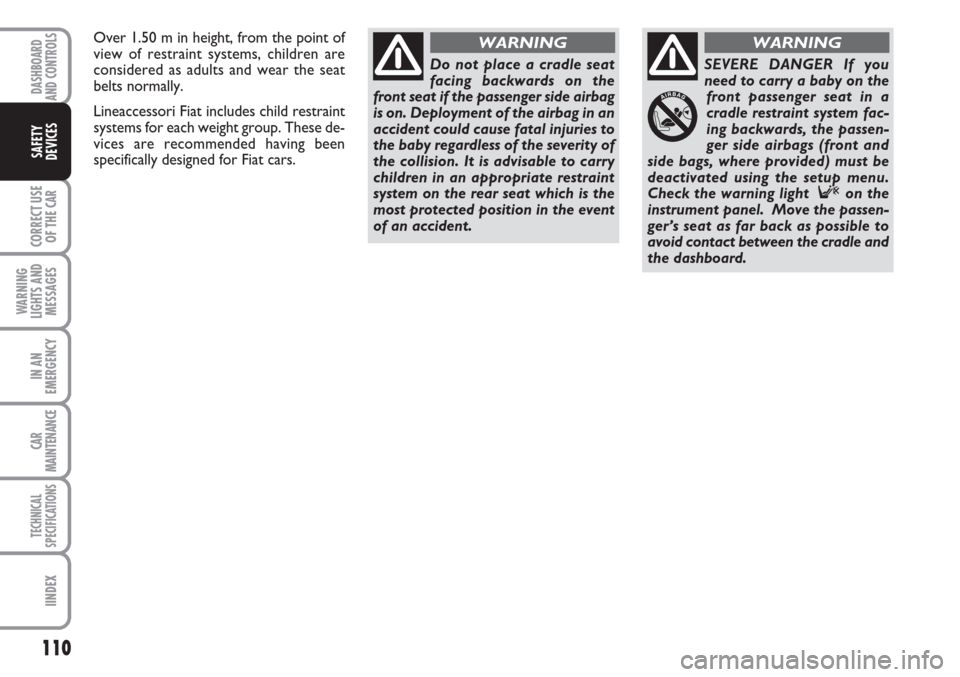
110
CORRECT USE
OF THE
CAR
WARNING
LIGHTS AND
MESSAGES
IN AN
EMERGENCY
CAR
MAINTENANCE
TECHNICAL
SPECIFICATIONS
IINDEX
DASHBOARD
AND CONTROLS
SAFETY
DEVICES
Do not place a cradle seat
facing backwards on the
front seat if the passenger side airbag
is on. Deployment of the airbag in an
accident could cause fatal injuries to
the baby regardless of the severity of
the collision. It is advisable to carry
children in an appropriate restraint
system on the rear seat which is the
most protected position in the event
of an accident.
WARNING
SEVERE DANGER If you
need to carry a baby on the
front passenger seat in a
cradle restraint system fac-
ing backwards, the passen-
ger side airbags (front and
side bags, where provided) must be
deactivated using the setup menu.
Check the warning light Fon the
instrument panel. Move the passen-
ger’s seat as far back as possible to
avoid contact between the cradle and
the dashboard.
WARNINGOver 1.50 m in height, from the point of
view of restraint systems, children are
considered as adults and wear the seat
belts normally.
Lineaccessori Fiat includes child restraint
systems for each weight group. These de-
vices are recommended having been
specifically designed for Fiat cars.
Page 112 of 230
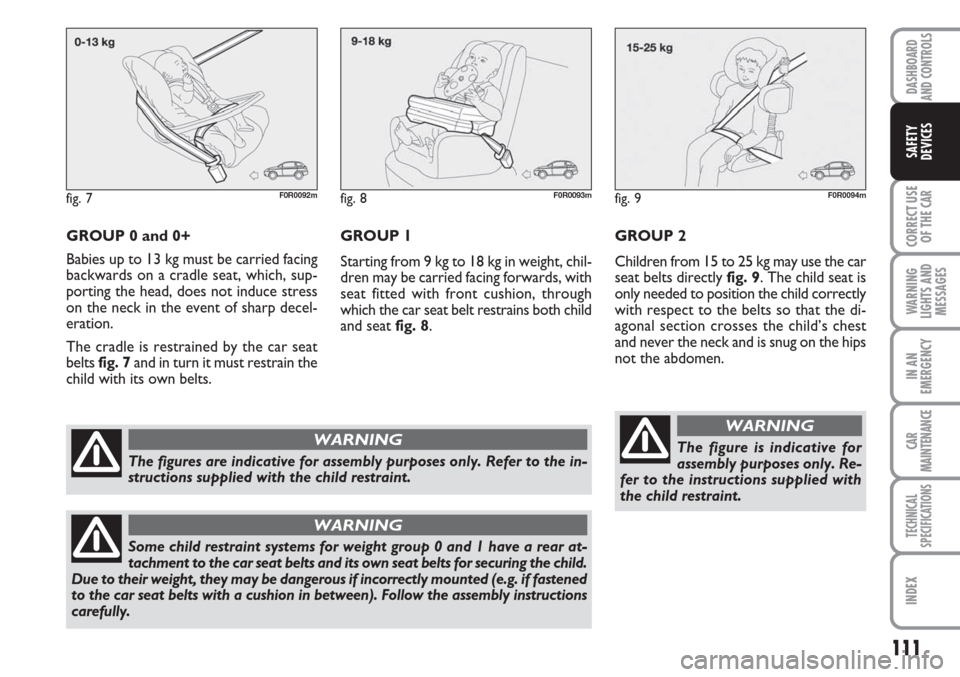
111
CORRECT USE
OF THE
CAR
WARNING
LIGHTS AND
MESSAGES
IN AN
EMERGENCY
CAR
MAINTENANCE
TECHNICAL
SPECIFICATIONS
INDEX
DASHBOARD
AND CONTROLS
SAFETY
DEVICES
GROUP 0 and 0+
Babies up to 13 kg must be carried facing
backwards on a cradle seat, which, sup-
porting the head, does not induce stress
on the neck in the event of sharp decel-
eration.
The cradle is restrained by the car seat
belts fig. 7and in turn it must restrain the
child with its own belts.
fig. 7F0R0092m
The figures are indicative for assembly purposes only. Refer to the in-
structions supplied with the child restraint.
WARNING
Some child restraint systems for weight group 0 and 1 have a rear at-
tachment to the car seat belts and its own seat belts for securing the child.
Due to their weight, they may be dangerous if incorrectly mounted (e.g. if fastened
to the car seat belts with a cushion in between). Follow the assembly instructions
carefully.
WARNING
fig. 8F0R0093mfig. 9F0R0094m
GROUP 2
Children from 15 to 25 kg may use the car
seat belts directly fig. 9. The child seat is
only needed to position the child correctly
with respect to the belts so that the di-
agonal section crosses the child’s chest
and never the neck and is snug on the hips
not the abdomen. GROUP 1
Starting from 9 kg to 18 kg in weight, chil-
dren may be carried facing forwards, with
seat fitted with front cushion, through
which the car seat belt restrains both child
and seat fig. 8.
The figure is indicative for
assembly purposes only. Re-
fer to the instructions supplied with
the child restraint.
WARNING
Page 113 of 230
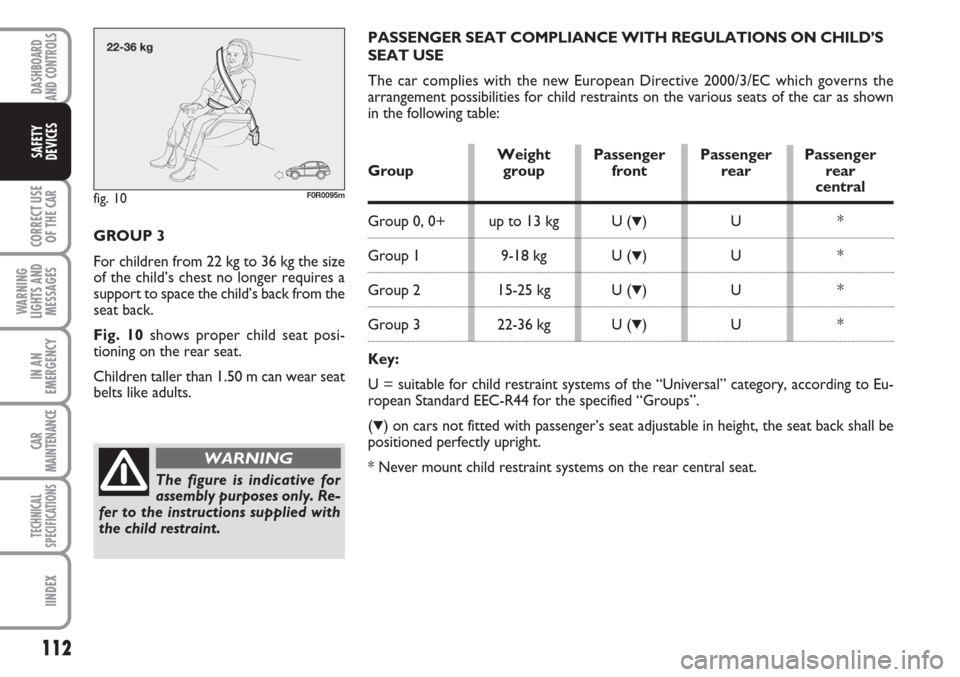
112
CORRECT USE
OF THE
CAR
WARNING
LIGHTS AND
MESSAGES
IN AN
EMERGENCY
CAR
MAINTENANCE
TECHNICAL
SPECIFICATIONS
IINDEX
DASHBOARD
AND CONTROLS
SAFETY
DEVICES
GROUP 3
For children from 22 kg to 36 kg the size
of the child’s chest no longer requires a
support to space the child’s back from the
seat back.
Fig. 10shows proper child seat posi-
tioning on the rear seat.
Children taller than 1.50 m can wear seat
belts like adults.PASSENGER SEAT COMPLIANCE WITH REGULATIONS ON CHILD’S
SEAT USE
The car complies with the new European Directive 2000/3/EC which governs the
arrangement possibilities for child restraints on the various seats of the car as shown
in the following table:
fig. 10F0R0095m
The figure is indicative for
assembly purposes only. Re-
fer to the instructions supplied with
the child restraint.
WARNING
Weight Passenger Passenger Passenger
Group group front rear rear
central
Group 0, 0+ up to 13 kg U (▼)U *
Group 1 9-18 kg U (▼)U *
Group 2 15-25 kg U (▼)U *
Group 3 22-36 kg U (▼)U *
Key:
U = suitable for child restraint systems of the “Universal” category, according to Eu-
ropean Standard EEC-R44 for the specified “Groups”.
(
▼) on cars not fitted with passenger’s seat adjustable in height, the seat back shall be
positioned perfectly upright.
* Never mount child restraint systems on the rear central seat.
Page 114 of 230
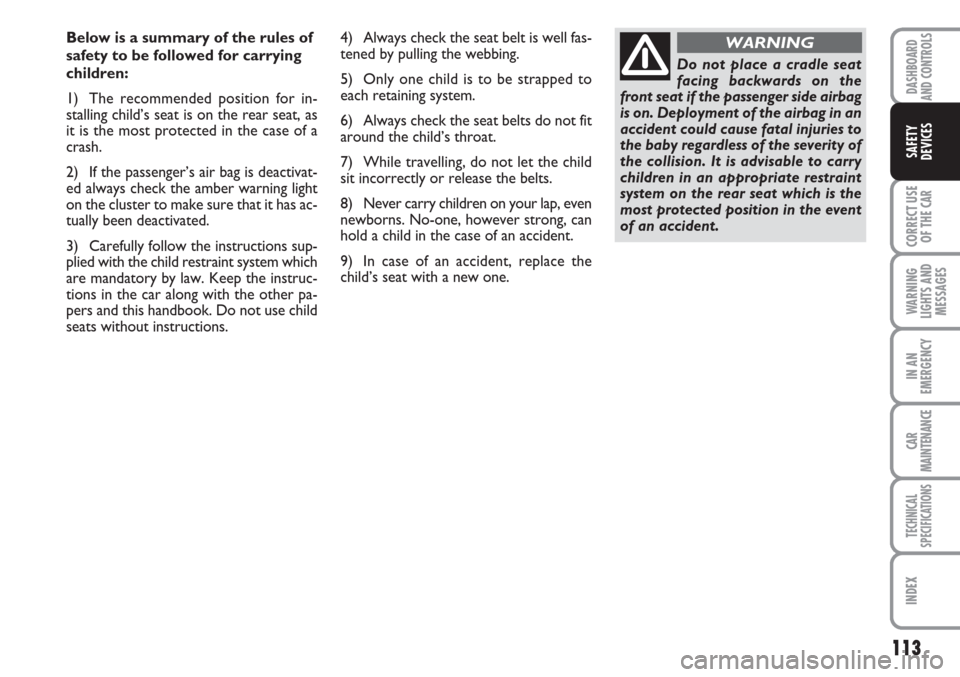
113
CORRECT USE
OF THE
CAR
WARNING
LIGHTS AND
MESSAGES
IN AN
EMERGENCY
CAR
MAINTENANCE
TECHNICAL
SPECIFICATIONS
INDEX
DASHBOARD
AND CONTROLS
SAFETY
DEVICES
Below is a summary of the rules of
safety to be followed for carrying
children:
1) The recommended position for in-
stalling child’s seat is on the rear seat, as
it is the most protected in the case of a
crash.
2) If the passenger’s air bag is deactivat-
ed always check the amber warning light
on the cluster to make sure that it has ac-
tually been deactivated.
3) Carefully follow the instructions sup-
plied with the child restraint system which
are mandatory by law. Keep the instruc-
tions in the car along with the other pa-
pers and this handbook. Do not use child
seats without instructions.4) Always check the seat belt is well fas-
tened by pulling the webbing.
5) Only one child is to be strapped to
each retaining system.
6) Always check the seat belts do not fit
around the child’s throat.
7) While travelling, do not let the child
sit incorrectly or release the belts.
8) Never carry children on your lap, even
newborns. No-one, however strong, can
hold a child in the case of an accident.
9) In case of an accident, replace the
child’s seat with a new one.
Do not place a cradle seat
facing backwards on the
front seat if the passenger side airbag
is on. Deployment of the airbag in an
accident could cause fatal injuries to
the baby regardless of the severity of
the collision. It is advisable to carry
children in an appropriate restraint
system on the rear seat which is the
most protected position in the event
of an accident.
WARNING
Page 115 of 230
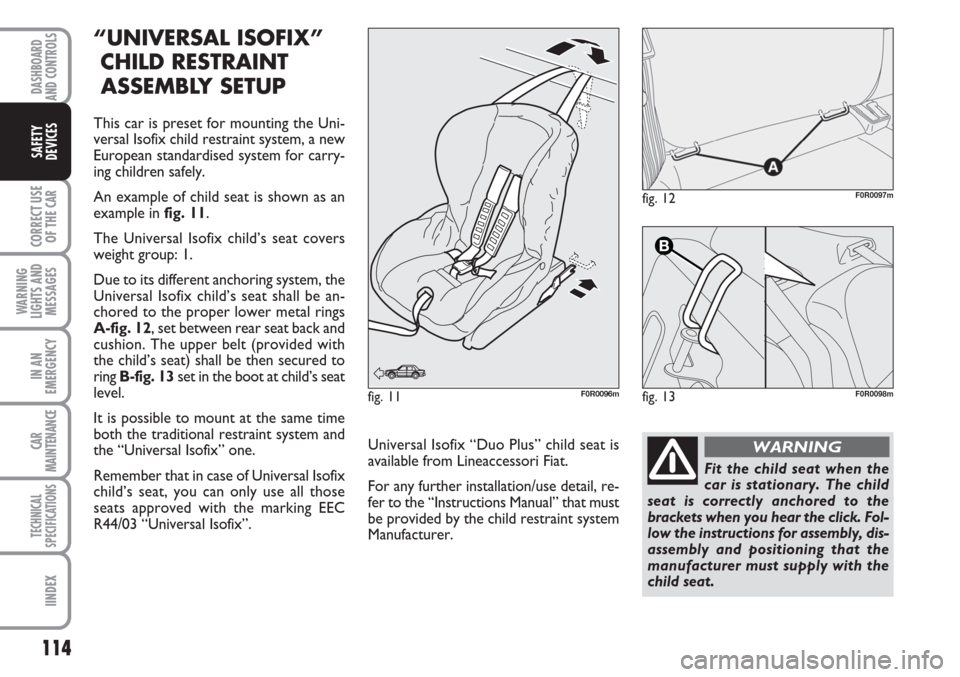
114
CORRECT USE
OF THE
CAR
WARNING
LIGHTS AND
MESSAGES
IN AN
EMERGENCY
CAR
MAINTENANCE
TECHNICAL
SPECIFICATIONS
IINDEX
DASHBOARD
AND CONTROLS
SAFETY
DEVICES
“UNIVERSAL ISOFIX”
CHILD RESTRAINT
ASSEMBLY SETUP
This car is preset for mounting the Uni-
versal Isofix child restraint system, a new
European standardised system for carry-
ing children safely.
An example of child seat is shown as an
example in fig. 11.
The Universal Isofix child’s seat covers
weight group: 1.
Due to its different anchoring system, the
Universal Isofix child’s seat shall be an-
chored to the proper lower metal rings
A-fig. 12, set between rear seat back and
cushion. The upper belt (provided with
the child’s seat) shall be then secured to
ring B-fig. 13set in the boot at child’s seat
level.
It is possible to mount at the same time
both the traditional restraint system and
the “Universal Isofix” one.
Remember that in case of Universal Isofix
child’s seat, you can only use all those
seats approved with the marking EEC
R44/03 “Universal Isofix”.
fig. 12F0R0097m
fig. 11F0R0096mfig. 13F0R0098m
Fit the child seat when the
car is stationary. The child
seat is correctly anchored to the
brackets when you hear the click. Fol-
low the instructions for assembly, dis-
assembly and positioning that the
manufacturer must supply with the
child seat.
WARNINGUniversal Isofix “Duo Plus” child seat is
available from Lineaccessori Fiat.
For any further installation/use detail, re-
fer to the “Instructions Manual” that must
be provided by the child restraint system
Manufacturer.
Page 116 of 230
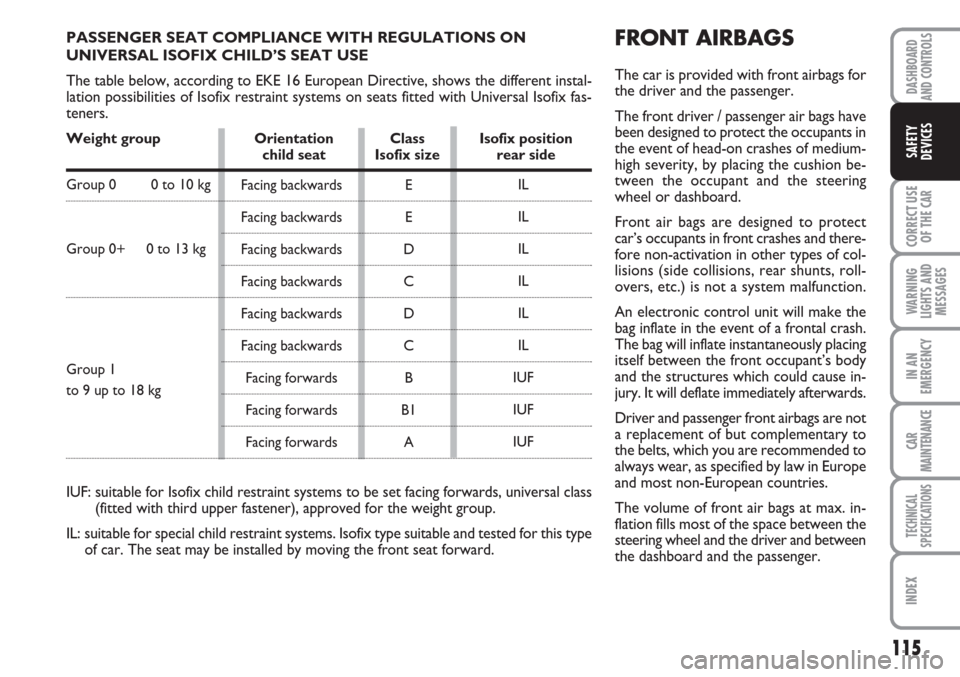
115
CORRECT USE
OF THE
CAR
WARNING
LIGHTS AND
MESSAGES
IN AN
EMERGENCY
CAR
MAINTENANCE
TECHNICAL
SPECIFICATIONS
INDEX
DASHBOARD
AND CONTROLS
SAFETY
DEVICES
FRONT AIRBAGS
The car is provided with front airbags for
the driver and the passenger.
The front driver / passenger air bags have
been designed to protect the occupants in
the event of head-on crashes of medium-
high severity, by placing the cushion be-
tween the occupant and the steering
wheel or dashboard.
Front air bags are designed to protect
car’s occupants in front crashes and there-
fore non-activation in other types of col-
lisions (side collisions, rear shunts, roll-
overs, etc.) is not a system malfunction.
An electronic control unit will make the
bag inflate in the event of a frontal crash.
The bag will inflate instantaneously placing
itself between the front occupant’s body
and the structures which could cause in-
jury. It will deflate immediately afterwards.
Driver and passenger front airbags are not
a replacement of but complementary to
the belts, which you are recommended to
always wear, as specified by law in Europe
and most non-European countries.
The volume of front air bags at max. in-
flation fills most of the space between the
steering wheel and the driver and between
the dashboard and the passenger.
E
E
D
C
D
C
B
B1
A
PASSENGER SEAT COMPLIANCE WITH REGULATIONS ON
UNIVERSAL ISOFIX CHILD’S SEAT USE
The table below, according to EKE 16 European Directive, shows the different instal-
lation possibilities of Isofix restraint systems on seats fitted with Universal Isofix fas-
teners.
Weight group Orientation Class Isofix position child seat Isofix size rear side
Group 0 0 to 10 kg
Group 0+ 0 to 13 kg
Group 1
to 9 up to 18 kg
IUF: suitable for Isofix child restraint systems to be set facing forwards, universal class
(fitted with third upper fastener), approved for the weight group.
IL: suitable for special child restraint systems. Isofix type suitable and tested for this type
of car. The seat may be installed by moving the front seat forward.
IL
IL
IL
IL
IL
IL
IUF
IUF
IUF Facing backwards
Facing backwards
Facing backwards
Facing backwards
Facing backwards
Facing backwards
Facing forwards
Facing forwards
Facing forwards
Page 117 of 230
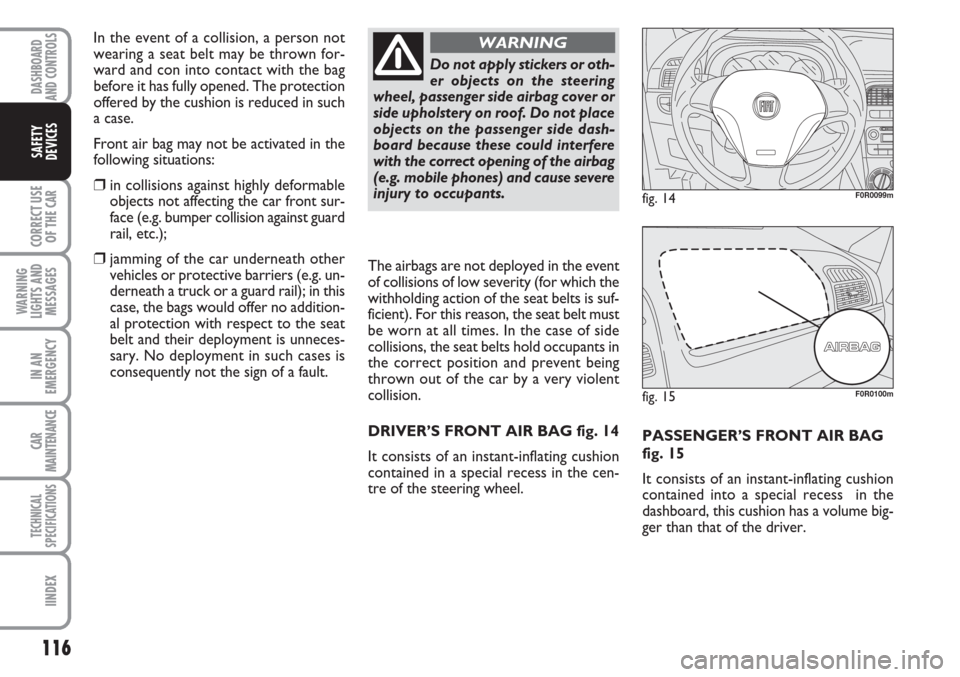
116
CORRECT USE
OF THE
CAR
WARNING
LIGHTS AND
MESSAGES
IN AN
EMERGENCY
CAR
MAINTENANCE
TECHNICAL
SPECIFICATIONS
IINDEX
DASHBOARD
AND CONTROLS
SAFETY
DEVICES
PASSENGER’S FRONT AIR BAG
fig. 15
It consists of an instant-inflating cushion
contained into a special recess in the
dashboard, this cushion has a volume big-
ger than that of the driver.
fig. 14F0R0099m
fig. 15F0R0100m
The airbags are not deployed in the event
of collisions of low severity (for which the
withholding action of the seat belts is suf-
ficient). For this reason, the seat belt must
be worn at all times. In the case of side
collisions, the seat belts hold occupants in
the correct position and prevent being
thrown out of the car by a very violent
collision.
DRIVER’S FRONT AIR BAG fig. 14
It consists of an instant-inflating cushion
contained in a special recess in the cen-
tre of the steering wheel.
Do not apply stickers or oth-
er objects on the steering
wheel, passenger side airbag cover or
side upholstery on roof. Do not place
objects on the passenger side dash-
board because these could interfere
with the correct opening of the airbag
(e.g. mobile phones) and cause severe
injury to occupants.
WARNINGIn the event of a collision, a person not
wearing a seat belt may be thrown for-
ward and con into contact with the bag
before it has fully opened. The protection
offered by the cushion is reduced in such
a case.
Front air bag may not be activated in the
following situations:
❒in collisions against highly deformable
objects not affecting the car front sur-
face (e.g. bumper collision against guard
rail, etc.);
❒jamming of the car underneath other
vehicles or protective barriers (e.g. un-
derneath a truck or a guard rail); in this
case, the bags would offer no addition-
al protection with respect to the seat
belt and their deployment is unneces-
sary. No deployment in such cases is
consequently not the sign of a fault.
Page 118 of 230
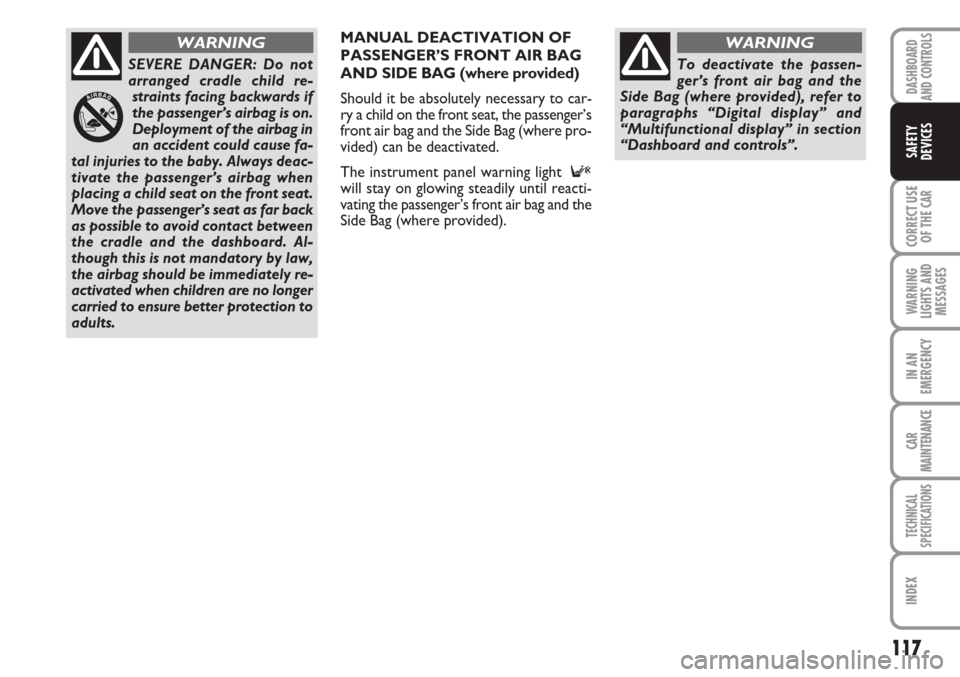
117
CORRECT USE
OF THE
CAR
WARNING
LIGHTS AND
MESSAGES
IN AN
EMERGENCY
CAR
MAINTENANCE
TECHNICAL
SPECIFICATIONS
INDEX
DASHBOARD
AND CONTROLS
SAFETY
DEVICES
MANUAL DEACTIVATION OF
PASSENGER’S FRONT AIR BAG
AND SIDE BAG (where provided)
Should it be absolutely necessary to car-
ry a child on the front seat, the passenger’s
front air bag and the Side Bag (where pro-
vided) can be deactivated.
The instrument panel warning light
Fwill stay on glowing steadily until reacti-
vating the passenger’s front air bag and the
Side Bag (where provided).
SEVERE DANGER: Do not
arranged cradle child re-
straints facing backwards if
the passenger’s airbag is on.
Deployment of the airbag in
an accident could cause fa-
tal injuries to the baby. Always deac-
tivate the passenger’s airbag when
placing a child seat on the front seat.
Move the passenger’s seat as far back
as possible to avoid contact between
the cradle and the dashboard. Al-
though this is not mandatory by law,
the airbag should be immediately re-
activated when children are no longer
carried to ensure better protection to
adults.
WARNING
To deactivate the passen-
ger’s front air bag and the
Side Bag (where provided), refer to
paragraphs “Digital display” and
“Multifunctional display” in section
“Dashboard and controls”.
WARNING
Page 119 of 230
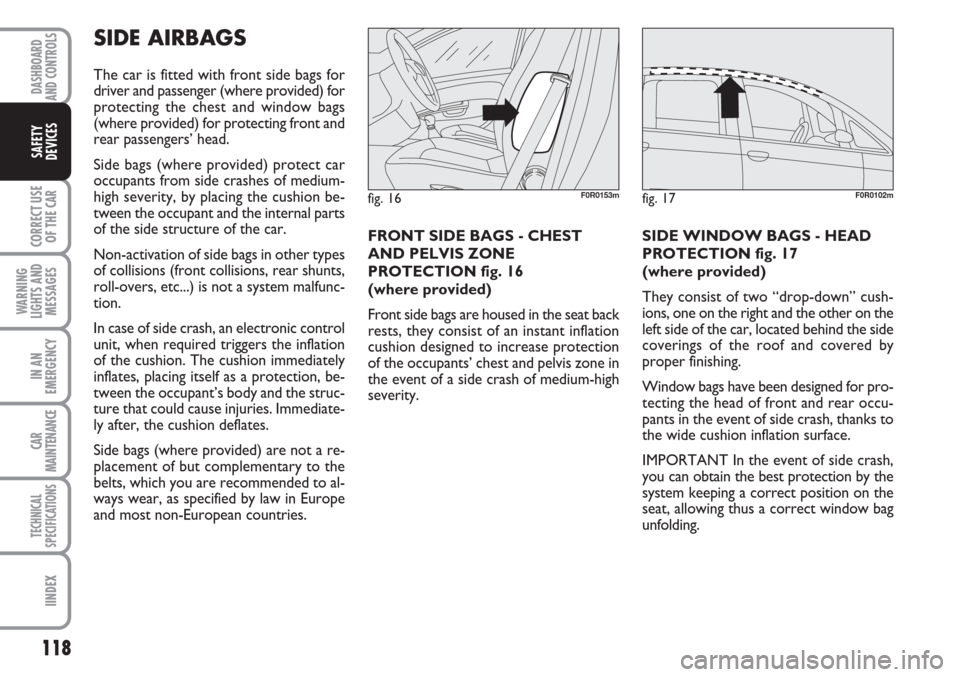
118
CORRECT USE
OF THE
CAR
WARNING
LIGHTS AND
MESSAGES
IN AN
EMERGENCY
CAR
MAINTENANCE
TECHNICAL
SPECIFICATIONS
IINDEX
DASHBOARD
AND CONTROLS
SAFETY
DEVICES
SIDE AIRBAGS
The car is fitted with front side bags for
driver and passenger (where provided) for
protecting the chest and window bags
(where provided) for protecting front and
rear passengers’ head.
Side bags (where provided) protect car
occupants from side crashes of medium-
high severity, by placing the cushion be-
tween the occupant and the internal parts
of the side structure of the car.
Non-activation of side bags in other types
of collisions (front collisions, rear shunts,
roll-overs, etc...) is not a system malfunc-
tion.
In case of side crash, an electronic control
unit, when required triggers the inflation
of the cushion. The cushion immediately
inflates, placing itself as a protection, be-
tween the occupant’s body and the struc-
ture that could cause injuries. Immediate-
ly after, the cushion deflates.
Side bags (where provided) are not a re-
placement of but complementary to the
belts, which you are recommended to al-
ways wear, as specified by law in Europe
and most non-European countries.FRONT SIDE BAGS - CHEST
AND PELVIS ZONE
PROTECTION fig. 16
(where provided)
Front side bags are housed in the seat back
rests, they consist of an instant inflation
cushion designed to increase protection
of the occupants’ chest and pelvis zone in
the event of a side crash of medium-high
severity.SIDE WINDOW BAGS - HEAD
PROTECTION fig. 17
(where provided)
They consist of two “drop-down” cush-
ions, one on the right and the other on the
left side of the car, located behind the side
coverings of the roof and covered by
proper finishing.
Window bags have been designed for pro-
tecting the head of front and rear occu-
pants in the event of side crash, thanks to
the wide cushion inflation surface.
IMPORTANT In the event of side crash,
you can obtain the best protection by the
system keeping a correct position on the
seat, allowing thus a correct window bag
unfolding.
fig. 16F0R0153mfig. 17F0R0102m
Page 120 of 230
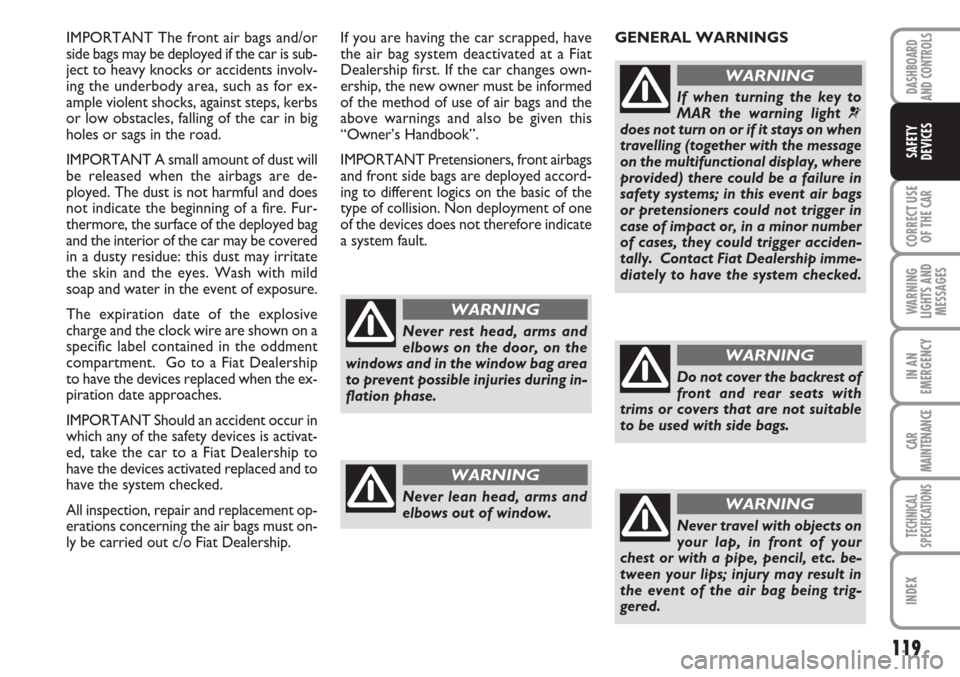
119
CORRECT USE
OF THE
CAR
WARNING
LIGHTS AND
MESSAGES
IN AN
EMERGENCY
CAR
MAINTENANCE
TECHNICAL
SPECIFICATIONS
INDEX
DASHBOARD
AND CONTROLS
SAFETY
DEVICES
IMPORTANT The front air bags and/or
side bags may be deployed if the car is sub-
ject to heavy knocks or accidents involv-
ing the underbody area, such as for ex-
ample violent shocks, against steps, kerbs
or low obstacles, falling of the car in big
holes or sags in the road.
IMPORTANT A small amount of dust will
be released when the airbags are de-
ployed. The dust is not harmful and does
not indicate the beginning of a fire. Fur-
thermore, the surface of the deployed bag
and the interior of the car may be covered
in a dusty residue: this dust may irritate
the skin and the eyes. Wash with mild
soap and water in the event of exposure.
The expiration date of the explosive
charge and the clock wire are shown on a
specific label contained in the oddment
compartment. Go to a Fiat Dealership
to have the devices replaced when the ex-
piration date approaches.
IMPORTANT Should an accident occur in
which any of the safety devices is activat-
ed, take the car to a Fiat Dealership to
have the devices activated replaced and to
have the system checked.
All inspection, repair and replacement op-
erations concerning the air bags must on-
ly be carried out c/o Fiat Dealership.If you are having the car scrapped, have
the air bag system deactivated at a Fiat
Dealership first. If the car changes own-
ership, the new owner must be informed
of the method of use of air bags and the
above warnings and also be given this
“Owner’s Handbook”.
IMPORTANT Pretensioners, front airbags
and front side bags are deployed accord-
ing to different logics on the basic of the
type of collision. Non deployment of one
of the devices does not therefore indicate
a system fault.
Never rest head, arms and
elbows on the door, on the
windows and in the window bag area
to prevent possible injuries during in-
flation phase.
WARNING
Never lean head, arms and
elbows out of window.
WARNING
GENERAL WARNINGS
If when turning the key to
MAR the warning light ¬does not turn on or if it stays on when
travelling (together with the message
on the multifunctional display, where
provided) there could be a failure in
safety systems; in this event air bags
or pretensioners could not trigger in
case of impact or, in a minor number
of cases, they could trigger acciden-
tally. Contact Fiat Dealership imme-
diately to have the system checked.
WARNING
Do not cover the backrest of
front and rear seats with
trims or covers that are not suitable
to be used with side bags.
WARNING
Never travel with objects on
your lap, in front of your
chest or with a pipe, pencil, etc. be-
tween your lips; injury may result in
the event of the air bag being trig-
gered.
WARNING